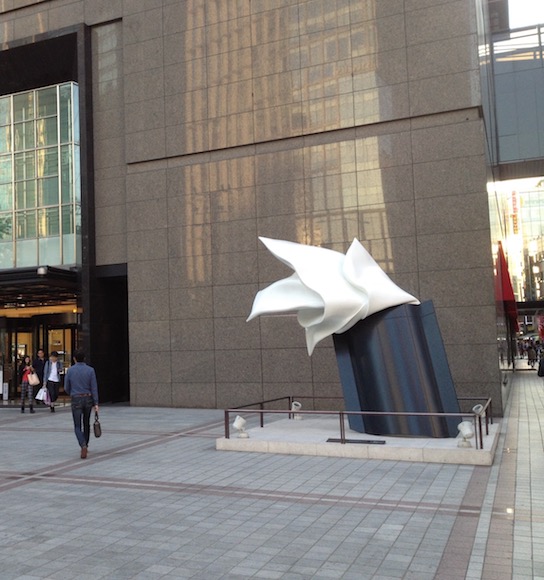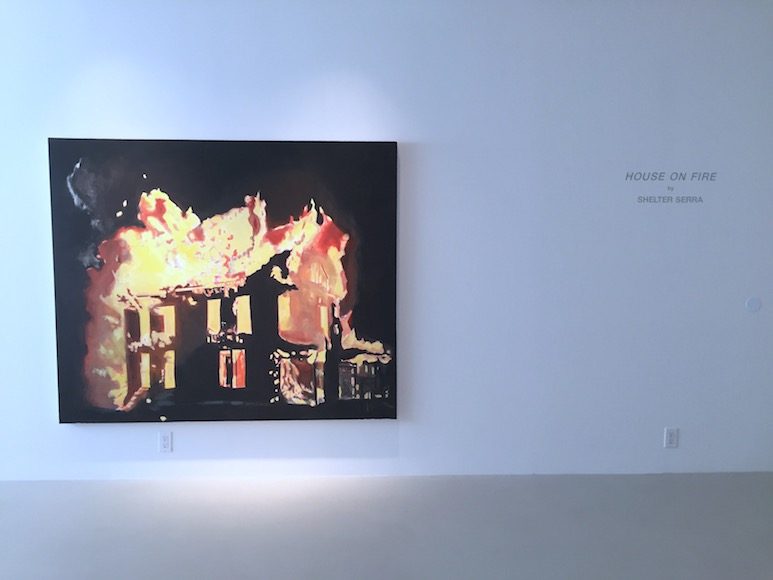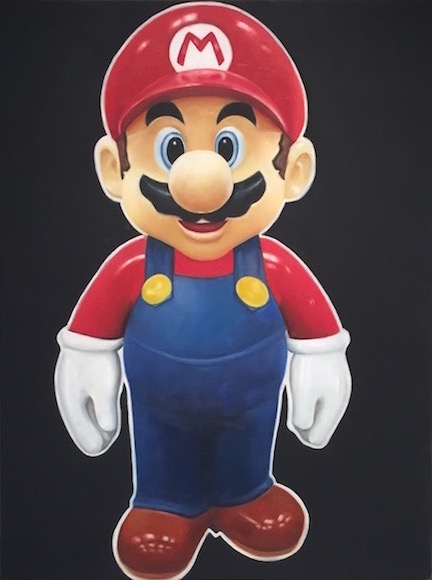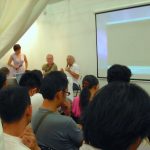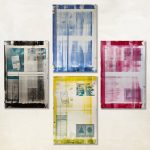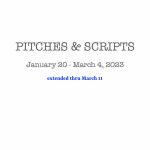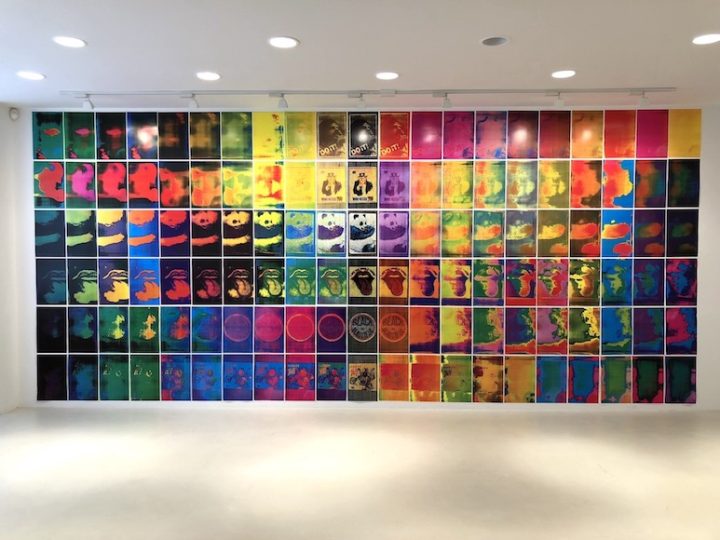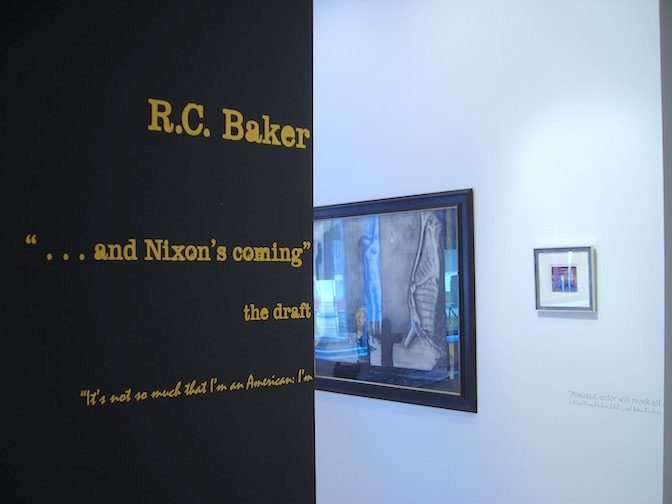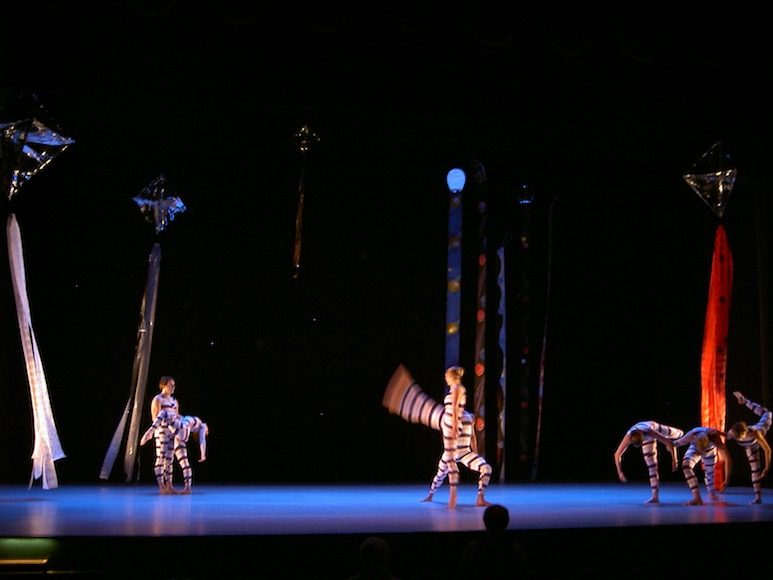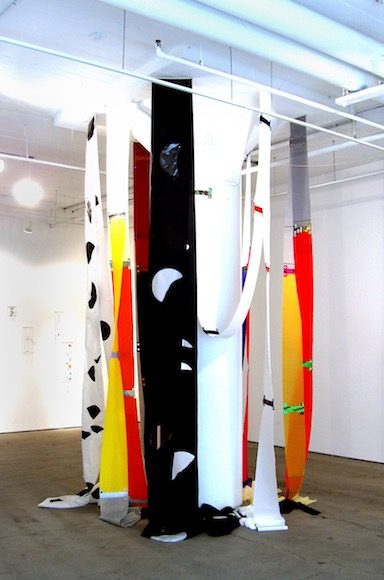LOUISE LAWLER
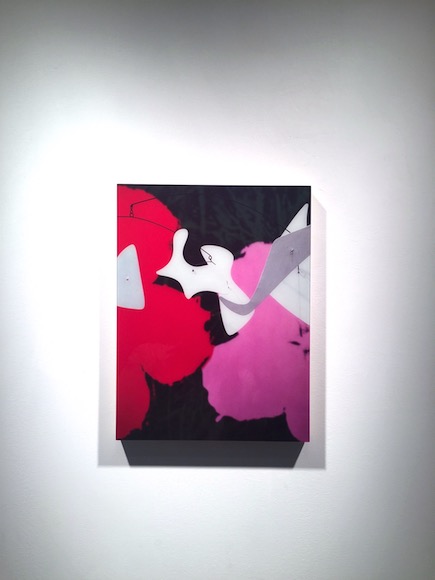
Too Easy, 2001/2010
Direct cibachrome face mounted to plexiwood
14 x 10.5 in. (35 x 27 cm)
Categories: artists
JANE FREILICHER
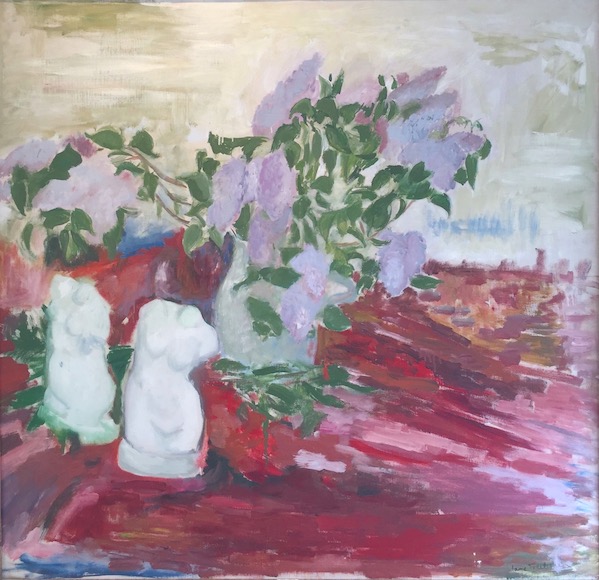
Lilacs and Torso, c.1955
Oil on canvas
43 x 43 in. (109 x 109 cm)
Categories: artists
FERNANDO BOTERO
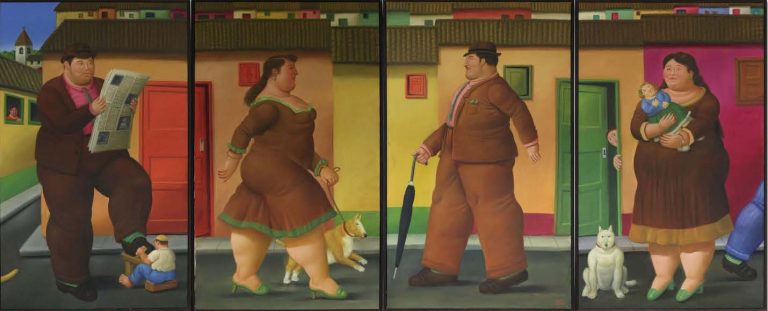
The Street, 1998
Oil on canvas 77 x 46 in. (196 x 17 cm) each, Quadtych
Categories: artists
“SHELTER SERRA SETS THE HOUSE ON FIRE”, by Ashley W. Simpson
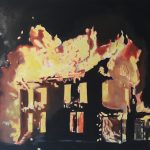
FASHION UNFILTERED, November 15, 2016
Over the past decade, the Bolia, California-raised artist Shelter Serra has recreated the Birkin in platinum silicone (2009’s “Homemade Hermes Birkin Bag”), transformed the Hummer into a baby blue rubber replica, and made “fake Roleys” available to the masses—selling the art items at just $40 each. This evening, Serra is celebrating the opening of his first solo exhibition, House on Fire at Baahng Gallery in New York City. The series is comprised of oil paintings and sculptures, works that address the direction—and implosion—of the American Dream, drawing in issues of luxury, surveillance, nostalgia, and classic Americana in its examination of what this consumption-driven ideal means in contemporary American society.
We spoke to Serra by phone—he was with his wife in Tokyo—on the night of the presidential election as returns were pouring in, and talked about how he came to these subjects, why the image of the “House on Fire” is so specifically American, and what we can do in the face of such anger. The timing of the discussion and exhibition opening couldn’t have been more harrowing, or relevant.
Ashley W. Simpson: I’m glad we’re talking now. I’m trying not to have an anxiety attack watching the results.
Shelter Serra: I was getting nervous and anxious.
AWS: I stopped looking. Anyway, I want to talk to you about this exhibition.
SS: Well, I guess it’s even more apropos now. I had been working on this group of work for eight or nine months, and one of the key paintings is called “House on Fire.” My idea behind it was the metaphor for the American consumeristic dream that either backfires or resets itself. The image came from the post-mortgage meltdown of 2007. Someone had actually burned down their house and committed suicide [inside it]; it was a foreclosure instance where it was like, he didn’t want the bank to have the house. It was in Georgia. And I just thought, Wow, that’s such an American “fuck you” to the system. [It also brought about] the idea of a country almost catching on fire. I hope Hillary wins, but I’m interested in how everyone has this perspective of the American Dream and what it has to do with commodification and dreams, and that’s different for every culture.
The oil paintings came out of working with sculpture and really wanting to go back to a more traditional medium that challenged my own personal technical abilities. Images are read, but the technical aspect should have a background of history. I try to make [the images] my own, but I do take from popular culture, different notions of American perspective— which is different from [that of] somebody from Tokyo or Germany or Spain. It has to do with the context. I always think that the context is an important factor in how people read things or how people interpret their experiences.
AWS: Aside from the burning house, how did you decide what images to work with?
SS: I think the notion of narrative was unavoidable. People try to make relationships between things they see to make sense of them. With something foreign, sometimes it’s more difficult for people to sequence things. I thought about creating a subtle timeline that maybe has to do with surveillance and technology and this idea of things being documented and how documentation is really a freezing of time. Not like in photography or stills from a movie, but in a way that captures the essence of a moment. There are some kids that are walking in a painting of after-school, and it’s that moment of time when you’re an adolescent and you have that notion of freedom between school and going home, and later in life, you look back and think, Wow, that was so fun. That notion of nostalgia. So the images were kind of all—I don’t want to use the word pulled—but they were pulled together to create this pseudo-narrative like in a picture book. So the idea was to put together images that were closely related, but fed into this idea of technology and surveillance and capturing what would be almost a moment in time.
AWS: How do you see this concept of the American dream and commodification right now? You’re looking at different versions of what that American Dream can be.
SS: The acquisition or consumption of images is different from acquiring an iPhone or a new house or car, but all of those things become kind of like building blocks in creating a person’s identity, and more and more, our society becomes peppered with these homogenous relations. Like, everybody feels like they have to have the latest phone. Everybody feels like their clothes get old and they have to renew them—but you know, good clothes last a long time—so the whole notion of style and fashion and trends kind of progresses the notion of alienation and inclusion.
I guess the idea of the images in the painting that are part of the show is that there seems to be a kind of a juxtaposition of different times going on, where now, even the seasons are all changing. The world is a changing place and people don’t want things to change. That notion of change is really exciting and adventurous. But the reality is that people revert back to a certain type of comfort. And unfortunately, that might be what’s happening with this election. In my mind, the idea of challenging the status quo is what progresses thought, progresses art, it progresses everything from architecture to engineering to music. You need people to break the rules, and the idea of breaking the rules is super attractive, but in reality, people don’t really want to take that jump off the high dive. They would rather sit there and watch somebody else do it.
AWS: Or they would rather stay within their comfort zone even if that space is miserable.
SS: That is my notion of the American Dream. It is that comfort zone. And it’s different for everybody. If you have the latest handbag or have a gun or you have the latest watch—that almost creates this comfort zone that people have subscribed to almost without thinking.
AWS: And how do you relate this back to the work you’ve done in the past? Obviously, there are some similar issues of commodification and luxury.
SS: I relate it to how things constantly have to renew themselves, but there are certain things that always float to the top, whether it be a Birkin bag or a Rolex or maybe even a Hummer truck. At a certain point, it was maybe being used for the American military and it was also the most popular car on the street that was like a gas guzzler. So, there are certain things that become identifiable as parts of people’s persona. Or extensions of their personality. But they’re just objects. They’re replaceable. And that’s where this notion of consumerism in my mind is this constant driving force of American culture, and people get programmed into thinking that they need these things when in reality, less is more.
AWS: What do you hope people take away as they engage with this exhibition?
SS: As an artist, my goal is to change the way people think. The smallest notion of putting something on the street and seeing something in a different light, or looking twice at something—that idea of slowing things down and looking at things for what they are and maybe not for what they are in a greater whole. And what that has to do with trends and going back to that word commodification is that everybody does have individuality. That notion of individuality is something I think everyone needs to cherish. It’s almost like going with your intuition. Don’t second guess yourself. Go with what you think is right and don’t let people change your goals. Because everyone is different and that’s what makes the world go round. And I guess as an artist, I’m against the notion of homogeny and things all kind of being the same. The idea of imagination is something that everybody needs to embrace. As things become easily identifiable and consumable, people loose the sense of imagination. I think that’s something people need to hold on to because you can ask questions of your environment instead of accepting the status quo.
AWS: What’s next for you?
SS: Continuing paintings that I think address skewed notions of Americana, but also working on installation pieces and bigger works that fill an environment. Something like a windmill being knocked down and plated gold. Half-scale. I made an Abrams tank for a collector in the Philippines that went out in front of his house. Instead of a statuary lion or a birdbath, he had a big tank. So, [I want to extend] that into a greater realm of sculpture or installation with the paintings. And there’s a show coming up in Marfa, Texas, that will kind of be fences and lawns and how fences in lawns are kind of seen as extensions of the home. So, I’m going to be working in that kind of extension of the domestic realm. I think it’s important for me right now to investigate that.
AWS: We’re all kind of thinking about fences right now…
SS: Well, Saudi Arabia just put up a 600-mile long fence to keep ISIS out, which I think is totally bizarre.
AWS: That’s completely bizarre.
It’s a pretty long fence. They’re doing it all over the world. That kind of incorporates some of the paintings I’m doing that have surveillance perspectives. The idea of technology and surveillance and double fences. The fence is never enough. The fence has to be observed. It’s like this snowball effect that we’ve created. That duality of the fence is something that I’m interested in exploring in the future.
House on Fire is on view at Baahng Gallery, located at 790 Madison Ave, New York, NY, through December 27th.
Source:
http://fashionunfiltered.com/culture/2016/shelter-serra-house-on-fire-baahng-gallery-exhibit
Related:

“SHELTER SERRA SETS THE HOUSE ON FIRE”, by Ashley W. Simpson
Categories: news
Tags: Shelter Serra
“SHELTER SERRA: EMPTY THE AMERICAN DREAM”, Frontrunner Magazine
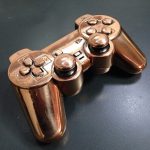
by Shana Beth Mason, November 3, 2016
Andy Warhol once said, “I don’t want it to be essentially the same – I want it to be exactly the same. Because the more you look at the same exact thing, the more the meaning goes away, and the better and emptier you feel.” This is a prophetic kind of epithet for the so-called “American Dream”, one that New York-based artist Shelter Serra takes rather seriously. He received his BA in Studio Art from the University of California (Santa Cruz) and an MFA in Painting & Printmaking from the Rhode Island School of Art & Design (RISD), but has developed his artistic practice in a very subdued, renegade fashion. He is a free agent, able to move about seamlessly though variant circles of contemporary art, both high and low. He seems to revel in movement, even though the things he references in his work are highly static and petrified. After what seems like forever, I caught up with Serra before the opening of his solo show House on Fire at Baahng Gallery (New York) on the 27th.
Shelter! How long has it been since we’ve last seen each other? Am I right in saying we met for the first time in 2010 at Primary Projects in Miami?
Hi Shana, It’s has been over a year. Too long! Last I saw you was here in NYC. You are right we did meet officially at Primary. I was doing the Fountainhead residency with the Mikesells, so I was in Miami a few weeks before Art Basel. That was a good year. Andrew Schoultz, Marc Bilj and RETNA were there too.
When I first met you, your work was centered on “shells” or “lost casts” of both luxury and threatening objects like Hummers, Birkin bags, nooses, and/or Rolex watches. Was this the very first stage of your practice, or was there other phases before this?
The first group of work that got shown publicly was the cast pieces. I have always drawn and painted. Before the objects, I was doing installations with grand opening flags and making enlarged Black Amex Cards (2007). To a degree, I have always been interested in the things that surround us daily.
With those works, I sensed that you had captured both the life and death of the object. By “emptying” the object of any sort of monetary value, you sort of distilled each object down to its sign/symbolic presence.
That’s an interesting way of looking at them, I like that. I was thinking about how the casting process stops time and freezes things. Whether it is a trucker’s hat, or a handbag, the moment something loses its immediate referent we see it differently, in a new light so to speak. Some people refer to those works as merely “copies”, or appropriation art, which is a broad way of interpreting the re-presentation of the object. I am more interested in the vessel and its relationship to the tropism of our society. By stripping away the external layers, I hope more is revealed.
Some recent work I’ve seen of yours are super-traditional paintings on canvas. When did these come about? Are they all a part of a congruous series?
I have been working on a specific group of work for the last three to four years. At RISD I studied painting and printmaking, so some things are hard to avoid. The oil paintings are in a sense a way to challenge myself to deal with the unavoidable aspects of image making, i.e. History, implications of the narrative, and memory. I was seeing so much zombie abstraction out there it made me wonder if the commodification of abstract art was fuelling the art bubble. Painting in a more traditional way helped me avoid being trendy. The new paintings are congruent to new sculptures and complement each other in ways that I did not expect. I have a show of the new works opening this month at Baahng Gallery in New York. There will be both sculpture and paintings.
One thing I’ve always liked about you is that you don’t affix ironclad “meanings” or “rumination” from your work. But do you have a baseline interest that has continually existed throughout your career as an artist?
Commodification and the paradox of the American Dream.
Source:
Related:

“SHELTER SERRA SETS THE HOUSE ON FIRE”, by Ashley W. Simpson
Categories: news
Tags: Shelter Serra
GARY HILL
In addition to presenting Gary Hill’s “Remembering Paralinguay” for Art Taipei 2008’s special exhibition, “Art & Tech – Wandering”, ZONE: Chelsea Center for the Arts presented “Language Willing”, “Church and State” and “Big Legs Don’t Cry” by Gary Hill.
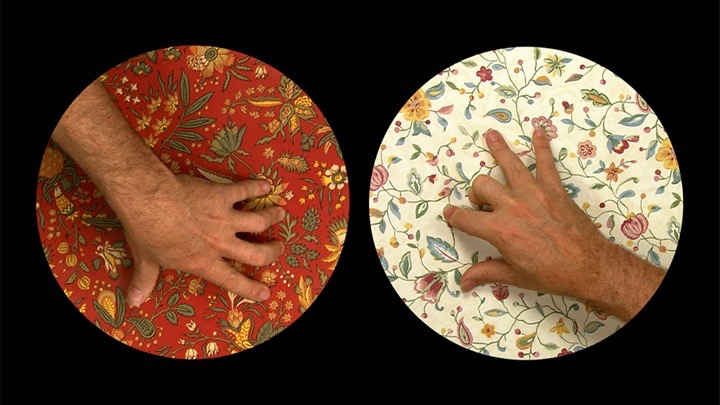
Language Willing, 2002
Single-channel video/sound installation
HD video projector (or HD monitor/display, size variable), two speakers, and HD video server (color; stereo sound)
Dimensions: if projected, projection size approx. 10 h. x 14 w. ft. (3.05 x 4.27 m.)
A text performed by the Australian poet-composer Chris Mann acts as a linguistic pulse for a pair of hands minding two discs, arranged side by side in a wide-format projection. The circular shapes, covered with flowery decorative patterns, one red and one creamy white, spin bi-directionally at varying times in unison and independently. Sounding like multiple voices, the somewhat musical speech runs wild through a nonlinear array of subjects held together (and apart) by self-reflexive phrases and punctuation. The fingers move decidedly over the moving surfaces, contorting as necessary in order to touch only the flowers and leaves. The movements of the fingers and discs and the rhythm and pitch of the voice become something of a physical/verbal dance.
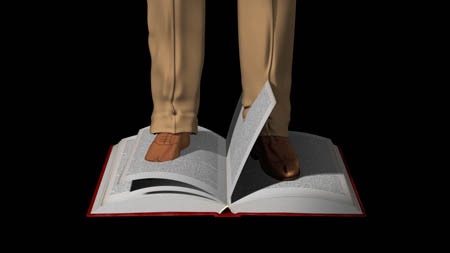
Big Legs Don’t Cry, 2005
Single-channel video installation, silent One 45-inch LCD monitor, one DVD player and one DVD
25 ½ h. x 43 w. inches (65 x 109 cm.)
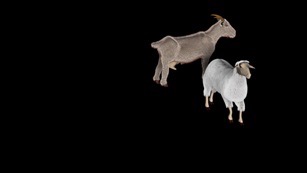
Church and State, 2005
Single-channel video/sound installation
One 45-inch LCD monitor, one DVD player and one DVD
25 ½ h. x 43 w. inches
Although related to the earlier series entitled Liminal Objects (1995 – 98), in which black-and-white, computer-generated animated images are coupled in continuous, interactive motion, the works in Hill’s recent series (which include Big Legs Don’t Cry, 2005; Attention, 2005; Church and State, 2005; and Spoonful, 2005) are rendered in color and created specifically for a wide-screen format, flat-panel LCD screen measuring 25 ½ h. x 43 w. inches (65 h. x 109 w. cm.). These works involve objects that, in a sense, violate each other’s borders in unpredictable ways, with the repetitive interaction and circular logic of their movement suggesting different readings of these veritable micro-scenes. Hinting at elements of symbology, they are “objects on the threshold of being something other than objects, ‘animated’ in a sense deeper and stranger than the technical.” [George Quasha in conversation with Gary Hill]
All above photos: Courtesy Donald Young Gallery, Chicago
Born in Santa Monica, California, USA
Lives and works in Seattle, Washington, USA
Gary Hill has been working with sculpture and electronic media since the early 1970’s and has produced a large body of both single-channel video works and mixed-media installations. His long time work with intramedia continues to explore an array of issues ranging from the physicality of language, synesthesia and perceptual conundrums to ontological space and viewer interactivity. His installation and performance work has been presented at museums and institutions throughout the world, and Hill has been the recipient of numerous awards and honors, most notably the Leone d’Oro Prize for Sculpture at the Venice Biennale in 1995, a John D. and Catherine T. MacArthur Foundation Grant in 1998, and the Kurt Schwitters Award in 2000.
My primary concern is work-as-inquiry – bringing the processual space to an interactive level that includes myself, the viewer and other possible collaborators into an ontological dialogue. I remain committed to cybernetics and the inherent nature of electronic media – real time feedback – as a rich strategy for working. At the same time, I am interested in bringing out the fallibility of technology – making work that suggests a loss of technology. I am also concerned with a number of dichotomies: mind/body, material/non-material, intuition/self-consciousness, sense/non-sense, etc.
The Brooklyn Rail reviews RC Baker’s solo exhibition, “…and Nixon’s coming” the draft
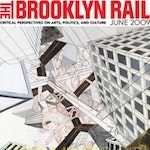
by Emily Warner
Zone: Contemporary Art, April 2-May 30, 2009
Kirby Holland, the fictional protagonist of R. C. Baker’s ongoing novel-cum-exhibition, explains his art-making process this way: “I put…these collages…together as grounds, the surface you paint on,” before laying the abstract designs on top: “I need some grit, something to hang my compositions on.” That description is a fitting one for Baker’s project as a whole, a collage-like, multimedia narrative that uses the structures of history as the grit for its fictional tale. The edges of the story emerge like pieces in a puzzle: chapter headings line the gallery walls (“Part i: The Fractured Century”), and scribbled notes and studies sketch out forms fully realized in paintings across the room. As a writer, artist, graphic designer, and art critic, R. C. Baker is a polymath, and his current project is a testament to the richness of overlapping artistic modes.
In its present installation, “…and Nixon’s coming” lives in two places, Baker’s in-progress novel draft (available for perusal and purchase at the gallery) and the exhibition. Neither is definitive. In fact, what makes the project so compelling is the detective work the viewer must do to fill in the story’s gaps, linking motifs from work to work, and from text to image. At the center of the narrative is Kirby Holland, to whom all the work in the show (made by Baker over the last few decades) is attributed. Written in the novel in a jaunty third-person, Holland seems more stock figure than fleshed-out character. It’s in his putative drawings, studies, and paintings—intimations of an inner personality and a set of working artistic concerns—that we really catch a believable glimpse of him.
That glimpse plunges us into a cultural and art historical tangle: in Holland’s oeuvre are references to Eakins, Hopper, comic books, Abstract Expressionism, war, and nuclear disaster. These references are constantly edited into new combinations and overlaps. Nothing is ever final in Baker’s project, and a sense of textural, pulpy accumulation—the accretion of drafts, collage layers, galley pages, reworked storyboards—runs throughout. A few pieces are executed directly on printing-press waste; in another series, flung drips of paint are outlined with careful, colored contours, lending high painterly abstraction the printed oomph of a comic book splat. It’s the visual slag of American history, and the manipulations and rewrites to which we subject it, that forms the real subject of the exhibition.
This reworking is not just an aesthetic project; the pithy (if dizzyingly self-referential) “After Krivov, Rockefellers, and Warhol” takes us into more pointedly political terrain. Caked gouache, splotched onto a woolly black xerox of Andy Warhol’s infamous “13 Most Wanted Men,” blots out the face of each mug shot. The work alludes to the whitewashing of the original 1964 Warhol mural by Nelson Rockefeller, and also to the actions of N. A. Krivov , a fictional Soviet filmmaker we meet in the novel as he peruses Stalin-doctored photographs with their unwanted members airbrushed out of the scene. Reproduction and erasure, Baker suggests, are dangerous if creative prospects, and we find them in the paranoid machinations of Soviet Russia as often as in the bourgeois mores of capitalist America.
Of course, the question remains: how effective is Baker’s occasionally bizarre project? For it to work, you need to be curious enough to follow up on its disparate threads. Many viewers may stop here, uninterested in penetrating its rather insular depths. Other authors have used a non-fiction model as the structure for their fictive worlds and characters (John Dos Passos’ USA trilogy and William Boyd’s Nat Tateboth come to mind), and yet Baker’s project stands somehow outside of this vein. His characters lack the practiced interior nuance of properly literary personages and the writing, while always vivid, can be heavy-handed. Indeed, thinking of “…and Nixon’s coming” as a literary project may be the wrong way to go. It’s more a purely visual narrative: the paintings, the sketches, the space of the show act as vignettes, imagistic moments taken from a shifting storyline.
The rewriting we see in the visual works is directed in toward the author, too: Baker has sampled from pieces completed long ago in other contexts, assigning them new authorship and meanings. Krivov, lying in the snow at the feet of Soviet interrogators, performs his own kind of interior rewrite, a cinematic fade-out of the scene around him: “Ah, look how the sun turns that scrub tree into black tendrils…You could fade into a witch’s claw or the Devil’s hand from that,” he thinks. “But that’s stupid and obvious.” There are moments in Baker’s project that feel obvious, too. But it’s nevertheless a vivid evocation of postwar America, and a compelling meditation on the politics of reproduction and appropriation. Eminently fluid and rewritable, Baker’s draft implies that making art is always a form of manipulation, and at times a dangerous one. His project speaks eloquently to the attempt to forge something real—to pick out a storyline—from the mess that is lived experience.
Source: https://brooklynrail.org/2009/06/artseen/rc-baker-and-nixons-coming-8260-the-draft
Related:

The Brooklyn Rail reviews RC Baker’s solo exhibition, “…and Nixon’s coming” the draft
JACKIE MATISSE
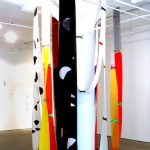
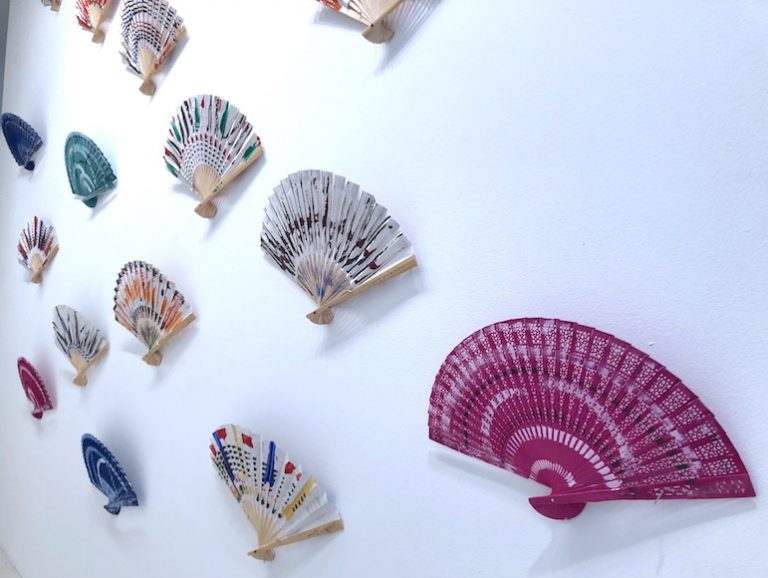
Works on paper
Jackie Matisse
Installation view
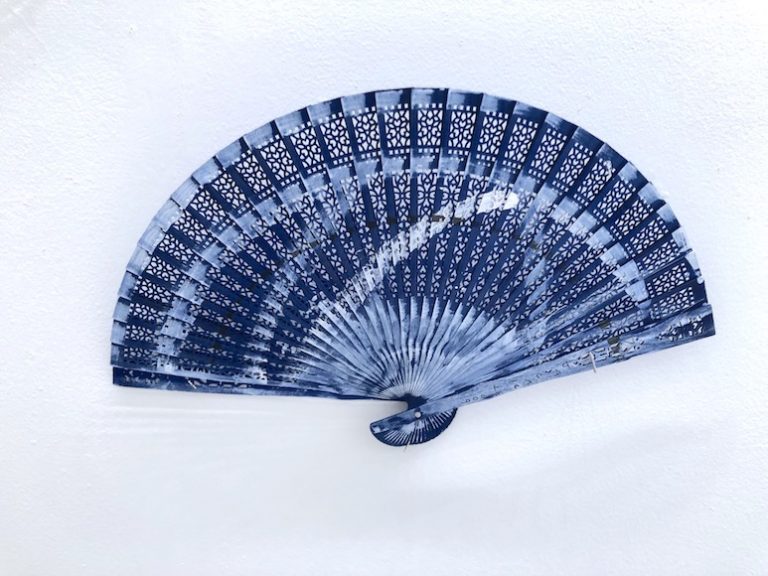
Works on paper
Jackie Matisse
Installation view
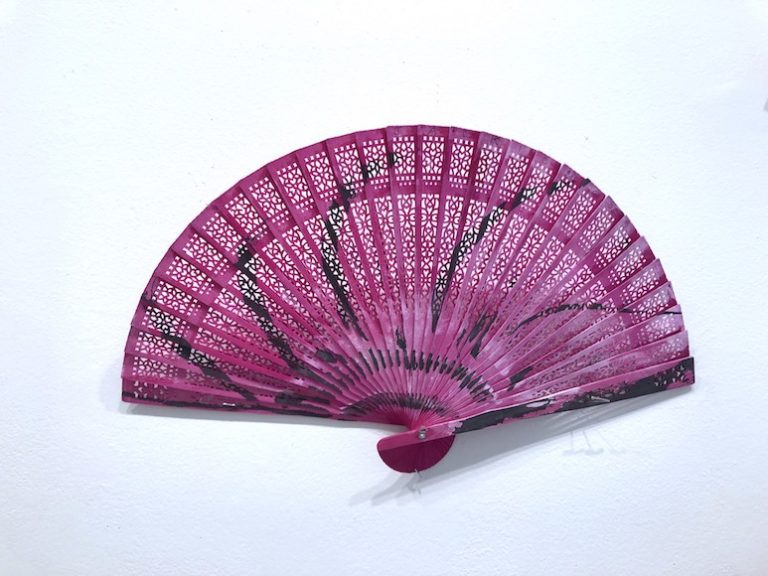
Works on paper
Jackie Matisse
Installation view
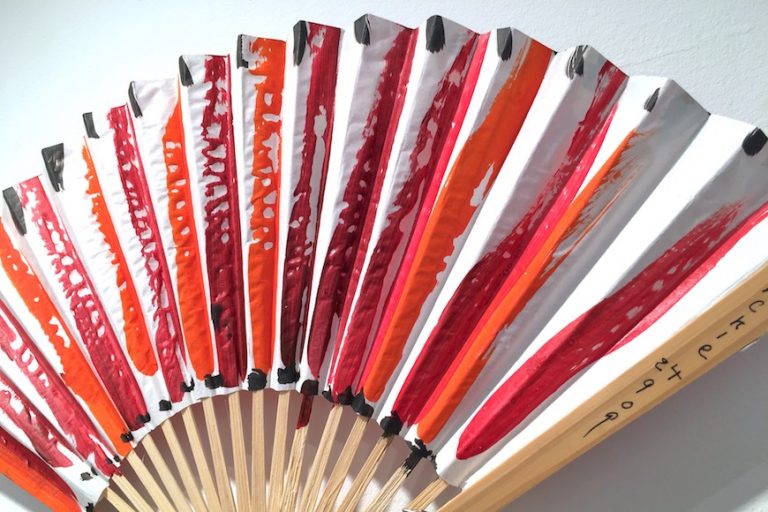
Fans
2009
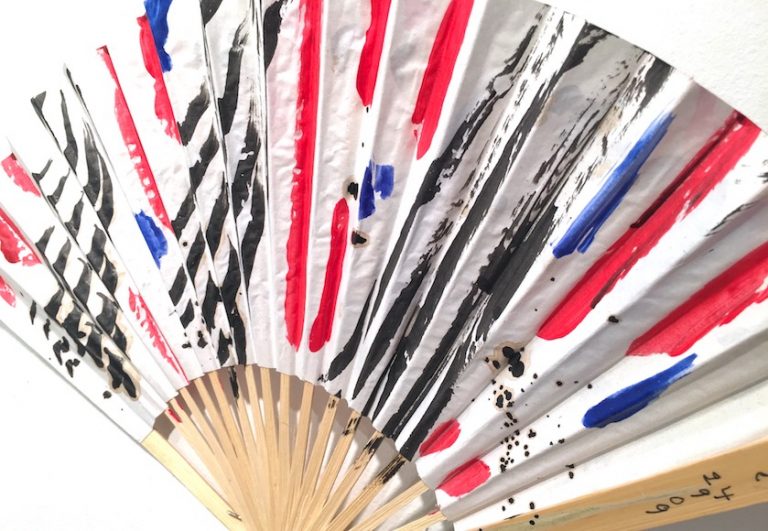
Fans
2009
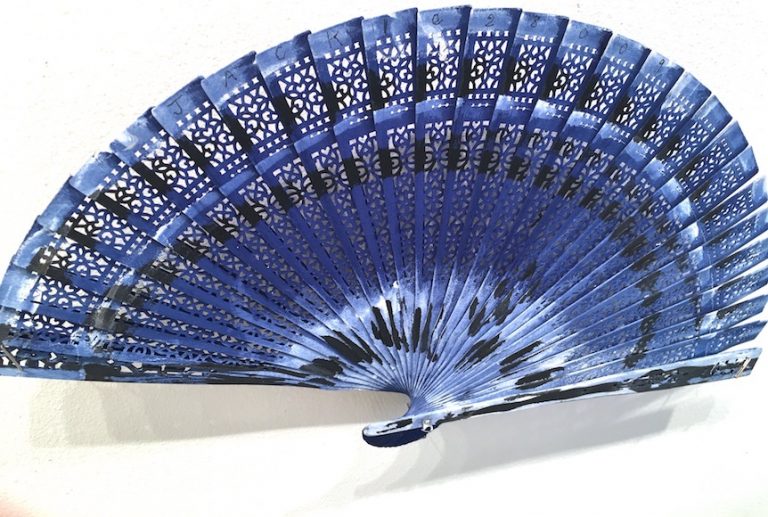
Fans
2009
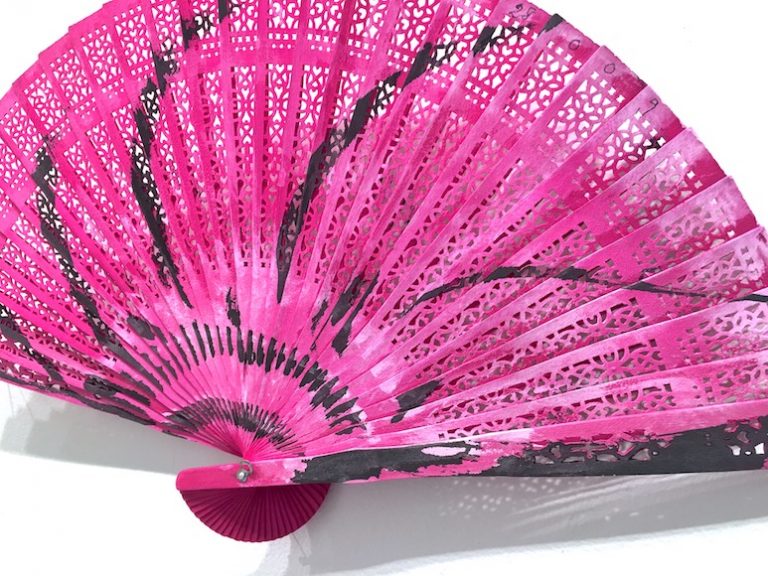
Fans
2009
Born in France, Jackie Matisse lived in New York until 1954. Since then she has lived in Paris making frequent visits to New York. Between 1959 and 1968 she worked for Marcel Duchamp, completing the assemblage of the “Boite en Valise”. At this time using her married name, Jacqueline Monnier, she began to make kites “in order to play with color and line in the sky”. In 1980 she showed kites which were created to be used underwater at the Betty Parsons Gallery in New York, and since then has continued to make kitelike objects intended for three different kinds of space: the sky, the sea, and indoor space, all linked through her use of movement.
In collaboration with Molly Davies, filmmaker and David Tudor, composer, she created two videos on her underwater and sky work. In the 1980’s she collaborated with David Tudor composer and musician. She just had a comprehensive show of her work at the Mengei International Museum in San Diego, California, U.S.A.
ONE PERSON EXHIBITIONS
2009 Heads and Tails: Hommage to Merce, ZONE Contemporary Arts, New York, NY
2005 New Art Volant, Zone Chelsea Center for the Arts, New York, N.Y
2002 Art Flying In and Out of Space, Virginia Tech’s Perspective Gallery and Virginia Tech Virtual Reality Cave, Blacksburg Virginia, April-May 2002. In collaboration with the University of Illinois at Chicago.Mountain Lake Workshop, April 2002 with Ray Kass, director.
2001 First event Echigo Triennale, August 2001, Sponsored by Art Front Gallery, Tokyo Japan
2000 Art that Soars, Mengei International Museum, San Diego, Ca. , U.S.A.
1999 Kitetail Cocktail, Goldie Paley Gallery, Philadelphia, Pa. U.S.A.
1998 Jacqueline Matisse Monnier Kiallitasa,Bartok 32 Galéria, Budapest, Hungary
1998 The World’s Most Beautiful Automobile, Milan, Italie , commission of ‘Wand’ a prize for Mr. Giovanni Agnelli.
1993 Magic Hair & Bottled Dreams,Galerie Satellite, Paris, France.
1988 Installation:Elle est rouge la petite fleur bleue, Musée Saint Roch, Issoudun, France.
1987 Galerie Jean Fournier, Paris, France
1985 Joan Mirò Foundation, Barcelona, Spain.
1984 Mobilis in Mobile, exhibition and air and underwater performance, Galeria Cadaquès, Spain.
Tangled Tails, performance and exhibition, Atelier Arc-en-ciel, Brest, France.
1982 Exposition à Poils, Samy Kinge Gallery, Paris, France
Ephemeral Gameswith performance, Galeria Cadaquès, Spain.
Underwater Kites and Moving Pieces, Anne Berthoud Gallery, London, England.
1981 The Traveling Exhibition, with performance, Philadelphia Museum of Art, Philadelphia Pa. U.S.A.
1980 Works Underwater and in Space, Betty Parsons Gallery, New York, N.Y., U.S.A.
1976 Kites, a Summer Celebration, with performance, ICA, London, England.
Galerie Jean Fournier, Paris, France.
1975 Formes d’Air et de Mouvement Musée des Sables d’Olonne, France.
- 9 Kite Tails Alexander Iolas Gallery, Paris, France.
GROUP SHOWS
2005 La Légèreté,Galerie Pixi, Paris, France
IS&T/SPIE International Symposium, Electronic Imaging 2005, January San Jose, California, Presentation of Art Volant dans l’espaceet ailleursby Dave Pape. No sound.
2004 Set for Cunningham Ballet Co. Joyce Theater, New York. NY
Festival International des Cerfs-Volants, Dieppe, France
Shaped by the Wind : Kites, The Hudson River Museum, Yonkers, New York
2003 Art Volant dans l’espace et ailleurs, presentation of a collaborative project of kites flying in virtual reality, with interactive sound by Tom Johnson; Nicéphore Days, ENSAM, Chalon-sur-Saône, France
Pour le Vacuovélodrome of Alfred Jarry, Nicéphore Days, ENSAM, Chalon-
Sur-Saône, France, 11 Kitetails
60 Poux du Ciel,Nicéphore Days, Espace des Arts, Chalon-sur-Saône, France.
Wabi Sabi in the West, A.V.C. Contemporary Arts Gallery, NY, New York
2002 Le Japon Mystérieux,Galerie Satellite, Paris, France
1997 Odeurs…Une Odyssée,Passage de Retz, Paris, France.
From one point to another, L’Atelier Soardi, Nice, France.
10 Jours d’Art Contemporain, Chateau de Nemours, Nemours, France.
1996 Happy End,Galerie Satellite, Paris France.
1995 First Symposium of Art Volant, Foundation Pilar i Joan Miro, Mallorca, Spain
1994 WeathervanesMusée Matisse, Le Cateau-Cambrésis, France.
Singuliers de L’art Galerie 2000, Paris, France.
1993 Drawing Sounds; An Installation in Honor of John Cage, by William Anastasi, Philadelphia Museum of Art, Philadelphia, Pa. U.S.A.
Rolywholyover A Circusby John Cage,The Museum of Contemporary Art, Los Angeles, The Menil Collection, Houston, Solomon R. Guggenheim Museum, New York City, Art Tower Mito, Japan.
They quoted Matisse, Galerie de France, Paris, France.
Qu’est-ce que j’ai fabriqué? Qu’est-ce que je n’ai pas fabriqué?
Jean Dupuy, Galerie Donguy, Paris, France;
1991 Le Musée Miniature, Galerie Pixi & Cie, Paris, France.
Les artistes décident de jouer, Association Campredon Art & Culture,
L’Isle-sur-la-Sorgue, France.
Zero Gravity, Art Advisory Service MOMA at City Bank, Long Island City, New York, U.S.A.
1990 Art, Culture et Foi, Galerie St. Séverin, Paris, France.
Art that Flies, with Curt Asker and Tal Streeter. The Dayton Art Institute, Dayton, Ohio, U.S.A.
Sixième Rencontre Internationale de Cerfs Volants, Dieppe, France.
1988 Festival des Ailes et de l’Espace, with performance, Centre d’Actions Culturelles, St Médard en Jalles, Bordeaux, France.
Lost and Found, The Fabric Workshop, Philadelphia, Pa. U.S.A1987
FIAC, Galerie Jean Fournier, Paris.
1986 XXXI Salon de Montrouge, Montrouge, France.
Inspiration comes from Nature, Jack Tilton Gallery, New York, N.Y., U.S.A.
Like Kites, MOMA, New York, N.Y., U.S.A.
1985 Plein Vent, A.R.E.A., Baie de Somme,France.
R.O.R.. Evening for the “Revue Parlée” with C. Asker, E. Ferrer, Y. Tono, H. Mathews. Presentation of her seven minute video film with David Tudor “Tailing a dream” and performance. Centre Pompidou, Paris, France.
1984 Underwater, Plymouth Arts Center, Plymouth, England.
1983 Fliegende Bilder, Fliegende Plastik, with performance, Föhr, Germany.
1982 Coup de Vent dans la Prairie, Atelier d’A., with performance, Caen, France.
1981 Drachen, Landesmuseum, Bonn, Germany.
1980 Group Show, Heath Gallery, Atlanta, Georgia, U.S.A..
Christmas Show, Betty Parsons Gallery, New York, U.S.A.
Métiers d’Art, Musée des Arts Décoratifs, Paris, France.
1979 Sculptures pour le ciel, Maison de la Culture, Rennes, France.
Messages pour l’espace, Centre d’actions culturelles de Sceaux, with performance, Sceaux, France.
1978 Kite Festival, Plaine de la Belle Etoile, Vincennes, France.
1977 Boites, ARC, Musée d’Art Moderne de la Ville de Paris, France.
Artistes-Artisans, Musée des Arts Décoratifs, Paris, France.
Pays, Visage de Vent, La Chartreuse de Villeneuve-lès-Avignon, with performance, Villeneuve-lès-Avignon, France.
La Boutique Aberrante de Daniel Spoerri, Centre Georges Pompidou, Paris, France.
Flags, Banners and Kites, Allied Arts Foundation, Seattle Wa. U.S.A.
1976 Vos Papiers, SVP, Musée des Sables d’Olonne, France.
Images pour le Ciel, Festival d’automne, exhibition and audiovisuel installation, Paris, France1975 Coup de Vent, with performance, Montrouge, Franc1974 Grandes Femmes, Petits Formats, Iris Clert Gallery, Paris, France.
1975 Coup de Vent, with performance, Montrouge, France 1974.
Grandes Femmes, Petits Formats, Iris Clert Gallery, Paris
IN COLLABORATION WITH DAVID TUDOR
2000 Sounds & Files, Kunstlehaus ,Vienna, Exposition of David Tudor’s sound table.
1990 Volatils and Sonic Reflections, Neue Musik München Klang Aktionen 90. Munich, Germany.
Volatils with Sonic Reflections, Jack Tilton Gallery, New York,N.Y., U.S.A.
1988 Lines and Reflections II, Rheinischen Musikfest, Kunstacademie, Düsseldorf, Germany.
Lines and Reflections I, performance with David Tudor, The Kitchen, New York,N.Y., U.S.A.
1986 Sound Totem, 9 Lines, performance with David Tudor and Molly Davies, Whitney Sculpture Court, New York, N.Y., U.S.A.
1985 R.O.R. evening for the Revue Parlée with C. Asker, E.Ferrer, Y. Tono, H. Mathews, Centre Pompidou Paris, France. Accompanied by Jackie Matisse’s production of a 7 minute video film called “Tailing a Dream“. Music David Tudor, camera Andy Ferullo and Molly Davies.
1984 Sea Tails, video installation, Centre Georges Pompidou, Paris, France.
1984 Sea Tails,David Tudor concert, Moderna Museet, Stockholm, Sweden.
1983 Sea Tails, David Tudor concert, Music Festival, Lugano, Italy.
1983 Sea Tails, video installation, with Molly Davies, and David Tudor, Frankfort, Germany.
PUBLICATIONS
2000 Art that Soars, Kites and Tails by Jackie Matisse, Exhibition Documentary Publication, Mengei International Museum, San Diego, Ca; U.S.A.
1997 The Blue Book,by Jackie Matisse, Editions de l’Onde
1996 Cerfs-Volants L’art en Ciel, Editions Alternatives Eric et Marc Domage
1991 Art That Flies, avec Curt Asker et Tal Streeter. The Dayton Art Institute, Dayton, Ohio.
1980 Water Story,Reaktion, Verlag galerie Leaman
Related:
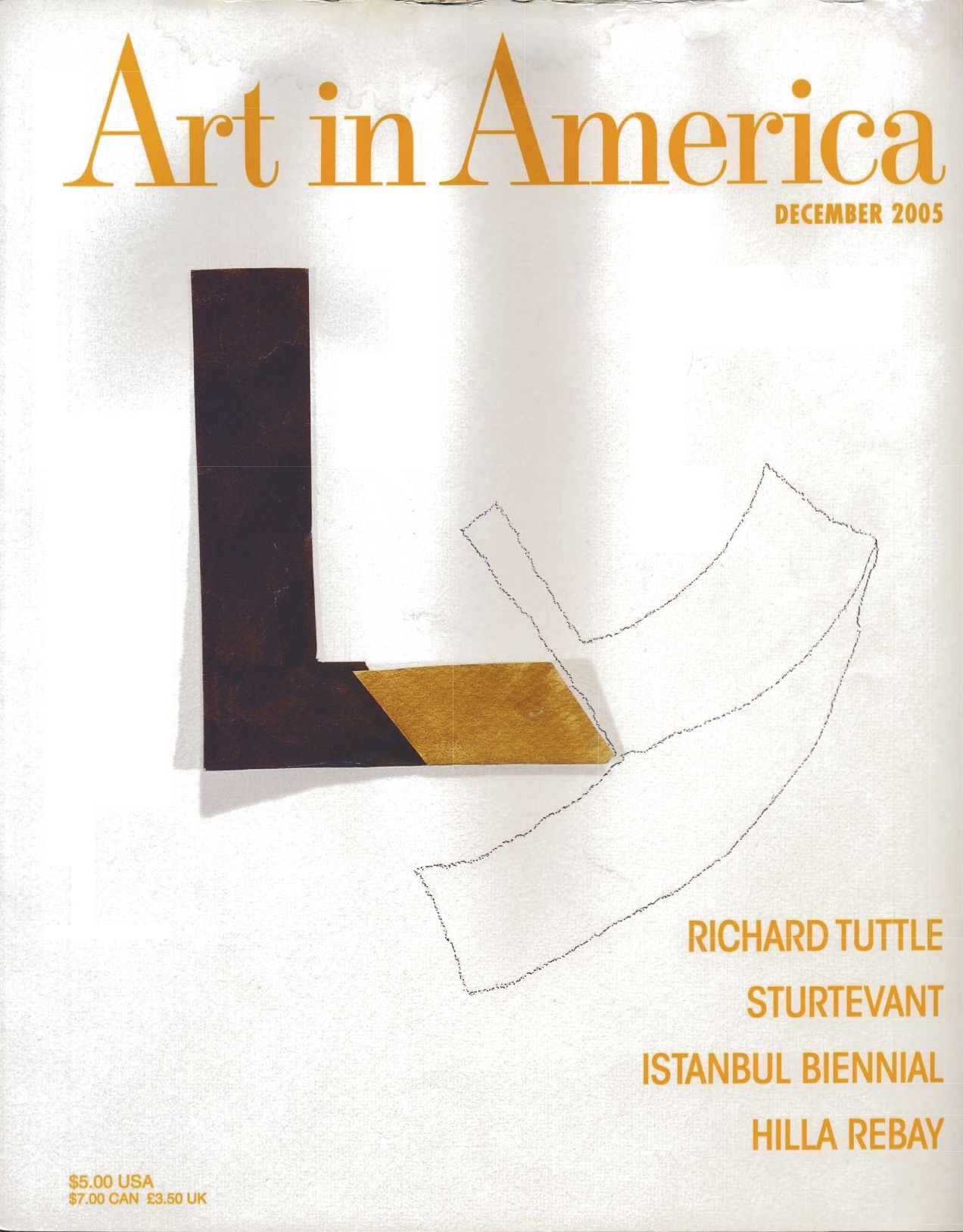
“Airborne Abstraction”, ART IN AMERICA reviews Jackie Matisse’s exhibition
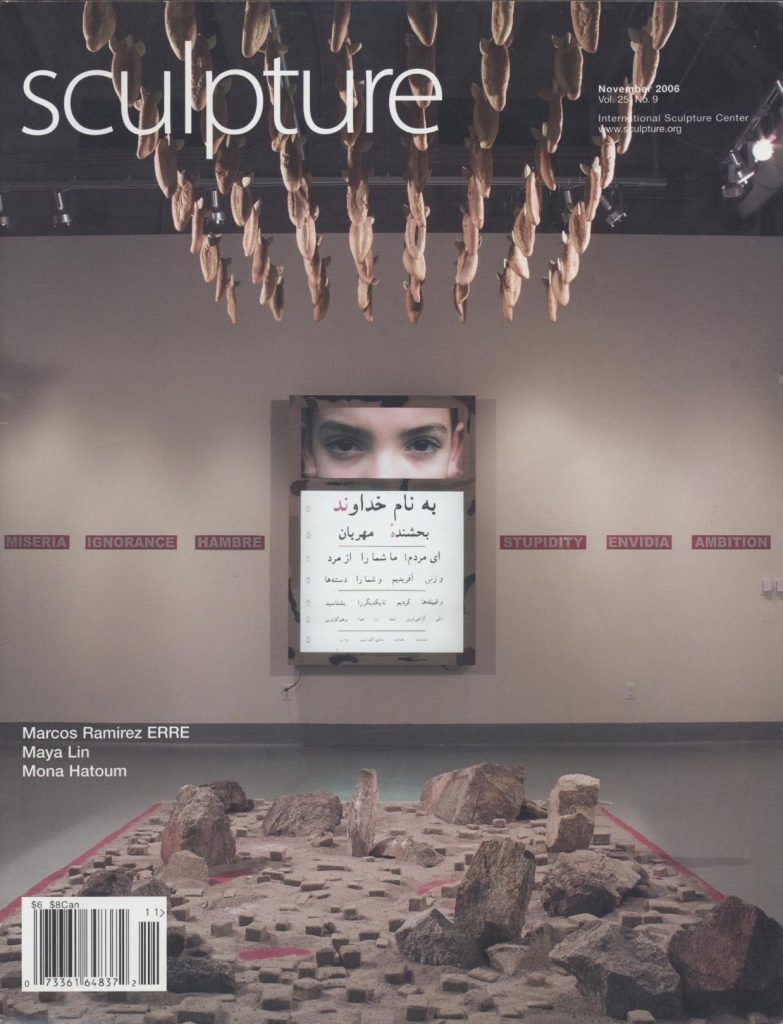
SCULPTURE MAGAZINE review on Jackie Matisse
Categories: artists
“Jackie Matisse” participated Virtuality Conference in Turin, Italy
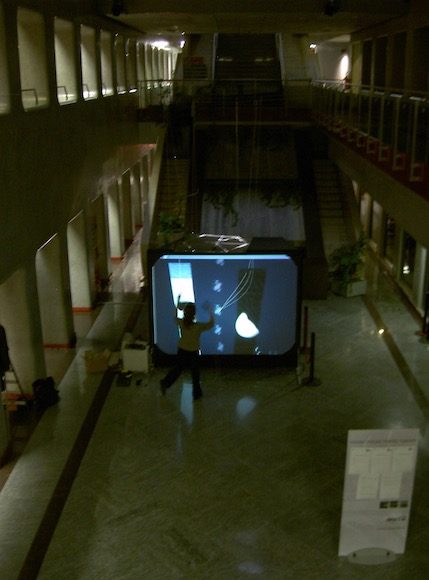
Kites Flying In and Out of Space
at Virtuality Conference in Turin, Italy
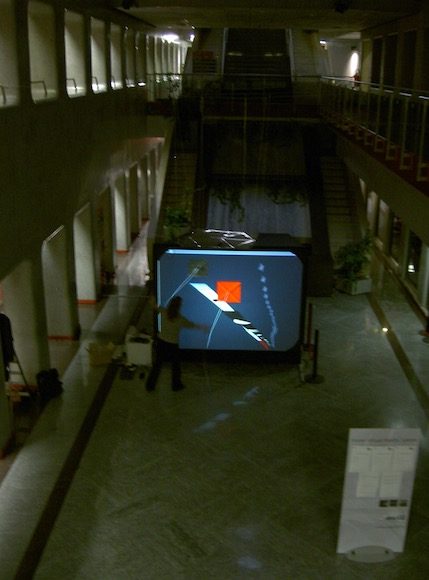
Kites Flying In and Out of Space
at Virtuality Conference in Turin, Italy
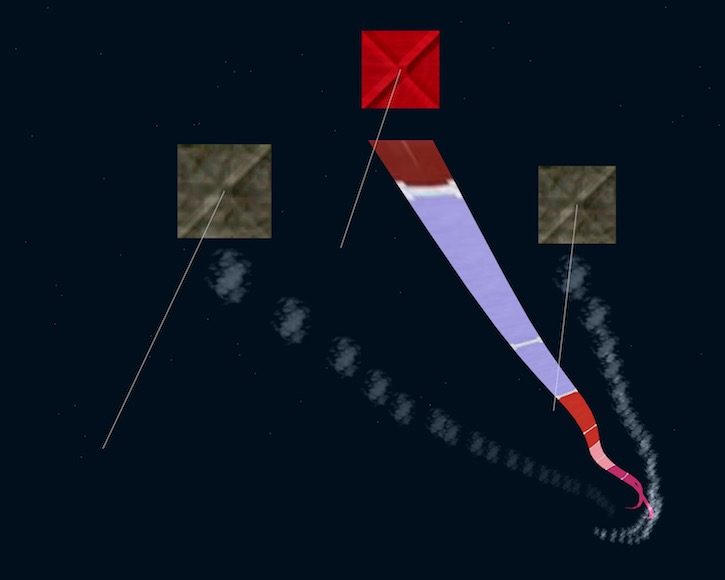
Kites Flying In and Out of Space
at Virtuality Conference in Turin, Italy
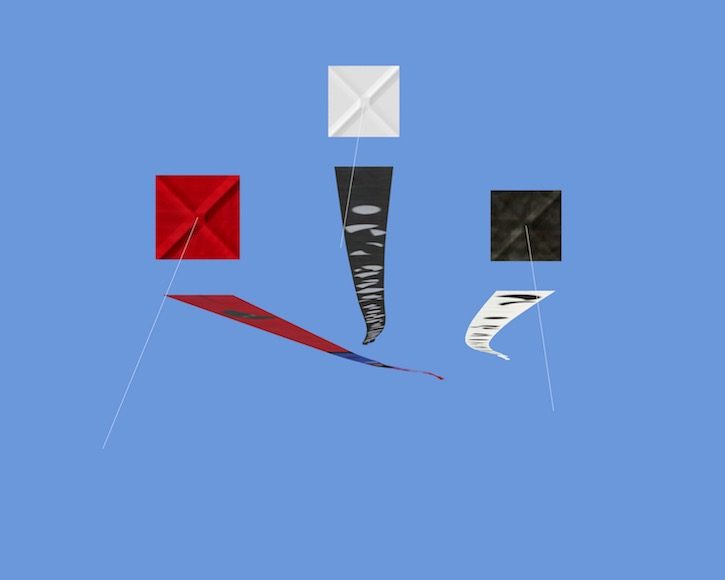
Kites Flying In and Out of Space
at Virtuality Conference in Turin, Italy
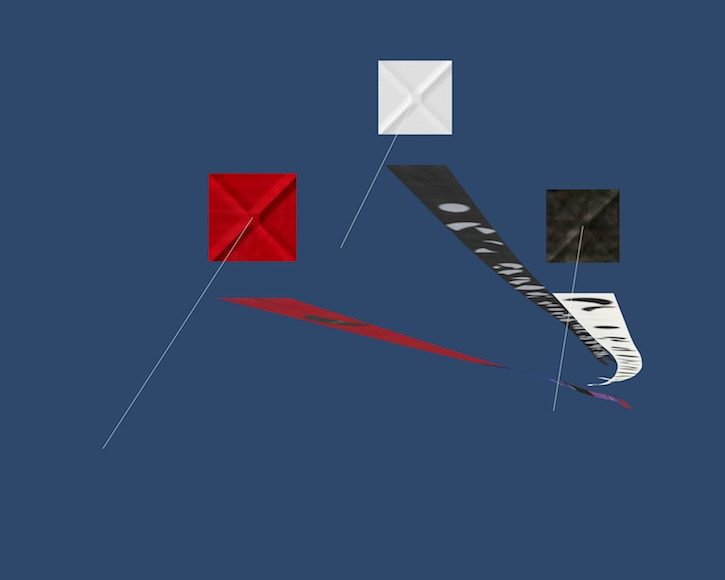
Kites Flying In and Out of Space
at Virtuality Conference in Turin, Italy
Virtuality is a premiere international event on Computer Graphics, Interactive Techniques, Digital Cinema, 3D Animation, Gaming and VFX. Every year, Virtuality proposes the most up-to-date discussion about cutting-edge applications of VR and Interactive Techniques in various fields. Particular attention is paid to industrial applications and to the multifaceted universe of cinema, including presentations by world-class experts of animation and visual effects.
“Kites Flying in and Out of Space is the first virtual reality (VR) art piece to use big broadband grid computing full-immersion techniques. For the kites to appear as three-dimensional forms in space, the computer-generated images must correspond perspectivally to a viewer’s location in the CAVE. A CAVE is a 10-by-10-foot structure in which computer-generated images are rear-projected onto the walls and floor so that a person standing in the CAVE is completely surrounded by stereoscopic computer graphics.
With Kites, a participant wears special glasses and holds a wand to control kite movements and to inject wind into the scene. The glasses, tracked using magnetic sensors, feed data to a computer that continually recalculates the kite forms and projects them back into the cave.
Scott Bradner of Network World called Kites Flying in and Out of Space the most emblematic demonstration of a real-time interactive, 3-D work of art and a beautiful personfication of distributed computing.”
(Taken from Howard Ristatti’s article “Jackie Matisse, Collaborations in Art and Science.” Sculpture Magazine. November, 2006.)
Jackie Matisse
Kites Flying In and Out of Space
Virtuality Conference
Turin, Italy
November 3 – 6, 2005
“Art Flying In and Out of Space” is a virtual reality simulation of Jackie Matisse’s real-world physical kites, although we may be calling it an ‘interactive stereoscopic installation’ rather than VR in this case. The installation is what’s called a projection-based VR system, as apposed to the perhaps more familiar head-mounted display, where users wear a helmet with computer displays attached. Projection-based VR started with the CAVE system developed at the University of Illinois’ Electronic Visualization Laboratory. One of the key elements of VR is to immerse the viewer in the virtual world (note that the meaning of ‘immersion’ is very loose and often up for debate). Head-mounted displays do this by attaching the display to the viewer’s head; projection-based systems do this by using very large screens that fill one’s field of view. A full CAVE is a 10 x 10 foot room with projections on multiple walls and the floor; due to space and budget restrictions, this gallery installation will only have a single 8 x 10 foot screen; when users stand up close, it will still (more or less) fill their field of view. The screen is rear-projected so that people can stand close without casting shadows on the computer imagery.
The display is stereoscopic, similar to 3D movies. The technology we use is polarized stereoscopy. Two projectors display different images, one for the left eye and one for the right eye. The projectors have different polarizing filters, and viewers wear matching polarized glasses to see the 3D effect.
A six-degree-of-freedom tracking system is used in VR systems to allow the computer to know where things (such as the user’s head & hand) are, allowing direct physical interaction with the virtual world, rather than having interaction mediated by a button/menu/etc GUI. In our case, we won’t be tracking the head (which normally is used to draw the graphics from the tracked person’s viewpoint), since several people will be viewing the display simultaneously, so we will use a fixed viewpoint for the graphics. We will use the trackers to allow 2 or 3 people to fly the kites – the ends of the virtual strings will be attached to the physical trackers, which the people can move around in 3D.
The sound for the piece is music by Tom Johnson. The music is dynamic – it plays in response to the motion of the kites, as manipulated by the viewers. The kites themselves involve a physics simulation known as a “mass-spring model”. Each kite is treated as a mesh of points; the points are affected by physical forces such as wind and gravity, as well as a “spring force” that keeps the kite together as a single surface. The earlier versions of the piece used supercomputers to perform detailed simulations of the kites, with the data being streamed back to the VR system over high-speed networks. As
we don’t have such resources for this installation, a much simplified version of the simulation will be running on the single Linux PC in the gallery. The motion of the simplified kites will still look very similar, just with less detail, and perhaps less realistic (although this is not likely to be apparent to most viewers).
The whole VR Installation consists of 2 or 3 PCs (one with a high-end “gaming quality” graphics card), an electromagnetic tracking system, 2 projectors, polarizing filters and glasses, a special polarizing-preserving screen, and speakers. We assembled the system ourselves at UB from these parts; some companies sell similar systems pre-packaged, but for a lot more money.
Dave Pape
Assistant Professor
Media Study, University at Buffalo
Related

“Airborne Abstraction”, ART IN AMERICA reviews Jackie Matisse’s exhibition

SCULPTURE MAGAZINE review on Jackie Matisse
Categories: projects
Tags: Jackie Matisse
